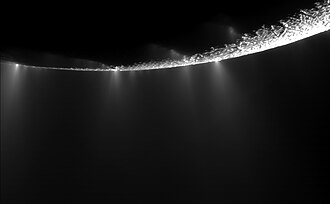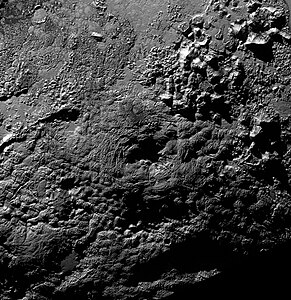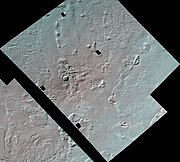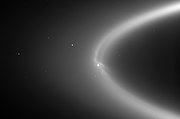Cryovolcano
A cryovolcano (sometimes informally referred to as an ice volcano) is a type of volcano that erupts gases and volatile material such as liquid water, ammonia, and hydrocarbons.
The erupted material is collectively referred to as cryolava; it originates from a reservoir of subsurface cryomagma. Cryovolcanic eruptions can take many forms, such as fissure and curtain eruptions, effusive cryolava flows, and large-scale resurfacing, and can vary greatly in output volumes. Immediately after an eruption, cryolava quickly freezes, constructing geological features and altering the surface.

Although rare in the inner Solar System, past and recent cryovolcanism is common amongst planetary objects in the outer Solar System, especially on the icy moons of the giant planets and potentially amongst the dwarf planets as well. As such, cryovolcanism is important to the geological histories of these worlds.
Like volcanism on the terrestrial planets, cryovolcanism is driven by escaping internal heat, often supplied by extensive tidal heating in the case of the moons of the giant planets. However, isolated dwarf planets are capable of retaining enough internal heat from formation and radioactive decay to drive cryovolcanism on their own, an observation which has been supported by both in situ and distant observations.
Mechanisms
A major challenge in models of cryovolcanic mechanisms is that liquid water is substantially denser than water ice, in contrast to silicates where liquid magma is less dense than solid rock. As such, cryomagma must overcome this in order to erupt onto a body's surface. It has been proposed that the exsolvation of compounds more volatile than water or the inclusion of various compounds can help lower the density of the cryomagma, or that alternatively, impurities in the ice shell can increase its density.: 182 Ammonia may be a common component of cryomagmas, and has been detected in the plumes of Saturn's moon Enceladus. A partially frozen Ammonia-water eutectic mixture can be positively buoyant with respect to the icy crust, enabling its eruption.: 766–767 Alternatively, the progressive pressurization of a subsurface ocean as it cools and freezes may be enough to drive cryomagma to ascend to the surface due to water's unusual property of expanding upon freezing. Internal ocean pressurization does not necessitate the addition of other volatile compounds, potentially explaining cryovolcanism on Jupiter's icy moons, where salt-dominated impurities likely serve to make cryomagma denser.: 183
Reservoirs
The most common reservoir of cryomagma is subsurface oceans.: 167 Subsurface oceans are widespread amongst the satellites of the giant planets and are largely maintained by tidal heating. Evidence for subsurface oceans also exist on the dwarf planets Pluto and, to a lesser extent, Ceres. Fractures in the ice shell, caused by stresses from diurnal tides, ice shell libration, internal expansion or contraction, or other sources of stress, can form direct conduits whence cryomagma may ascend from.: 185
Alternatively, material may upwell through solid convection or density differences within the ice shell, ascending without the need for fractures or a subsurface ocean. The material may then melt into subsurface pockets of cryomagma due to warm ice transferring heat to impure, lower melting point ice, which may then erupt or form diapirs.: 189–190
Composition
Besides water, cryomagma may contain additional impurities, drastically changing its properties.
| Cryomagma composition, mass % | Melting point (K) | Liquid density (g/cm3) | Liquid viscosity (Pa·s) | Solid density (g/cm3) |
|---|---|---|---|---|
| Pure water 100% H2O | 273 | 1.000 | 0.0017 | 0.917 |
| Brine 81.2% H2O, 16% MgSO4, 2.8% Na2SO4 | 268 | 1.19 | 0.007 | 1.13 |
| Ammonia and water 67.4% H2O, 32.6% NH3 | 176 | 0.946 | 4 | 0.962 |
| Ammonia, water, and methanol 47% H2O, 23% NH3, 30% CH3OH | 153 | 0.978 | 4,000 | – |
| Nitrogen and methane 86.5% N2, 13.5% CH4 | 62 | 0.783 | 0.0003 | – |
| Basaltic lava (comparison): 23–25 | – | – | ~10-100 | – |
Types of cryovolcanism
Explosive eruptions

Explosive cryovolcanism, or cryoclastic eruptions, is expected to be driven by the exsolvation of dissolved volatile gasses as pressure drops whilst cryomagma ascends, much like the mechanisms of explosive volcanism on terrestrial planets. Whereas terrestrial explosive volcanism is primarily driven by dissolved H2O, CO2, and SO2, explosive cryovolcanism may instead be driven by methane and carbon monoxide. Upon eruption, cryovolcanic material is pulverized in violent explosions much like volcanic ash and tephra, producing cryoclastic material.: 768
Effusive eruptions
Effusive cryovolcanism takes place with little to no explosive activity and is instead characterized by widespread cryolava flows which cover the pre-existing landscape. The resulting structure depends on the viscosity of the erupted material. Effusive cryovolcanism can resurface large regions and form expansive, relatively flat plains, similar to shield volcanoes and flood basalt eruptions on terrestrial planets. More viscous erupted material does not travel as far, and instead can construct localized high-relief domes and edifices more akin to lava domes. No instances of active effusive cryovolcanism have been observed.: 199–200
Observations
Ceres
Ceres remains the innermost cryovolcanically active body in the Solar System. Upon the arrival of the Dawn orbiter, the dwarf planet was discovered to have numerous bright spots (designated as faculae) located within several major impact basins, most prominently in the center of Occator Crater. These bright spots are composed primarily of various salts, and have been hypothesized to have formed from impact-induced upwelling of subsurface material and may indicate that Ceres had a subsurface ocean in its past. Dawn also discovered Ahuna Mons and Yamor Mons (formerly Ysolos Mons), two prominent isolated mountains which are hypothesized to be young cryovolcanic domes. It is expected that cryovolcanic domes eventually subside after becoming extinct due to viscous relaxation, flattening them. This would explain why Ahuna Mons appears to be the most prominent construct on Ceres, despite its geologically young age.
Europa
Europa receives enough tidal heating from Jupiter to sustain a global liquid water ocean, and as such surface is exceedingly young, at roughly 60 to 90 million years old.: 452 Its most striking features, a dense web of lineae, appear to be the sites of active resurfacing on Europa, proceeding in a manner similar to Earth's mid-ocean ridges, and Europa may experience a form of subduction in its icy crust.
Despite its young surface age, few, if any distinct cryovolcanoes have been definitively identified on the Europan surface in the past.: 193–194 Nevertheless, observations of Europa from the Hubble Space Telescope hinted at the existence of weak, possibly cryovolcanic plumes. More recent analyses of some Europan surface features have proposed cryovolcanic origins for them as well; Europa's chaos terrain has been interpreted as the site of very shallow cryomagma lakes, and a field of cryovolcanic cones has been tentatively identified near Argadnel Regio.
Ganymede
Ganymede's surface, like Europa's, is heavily tectonized yet appears to have few cryovolcanic features. Ganymede's surface has several irregularly-shaped depressions (termed paterae) which have been identified as candidate cryovolcanic calderas.
Enceladus

Saturn's moon Enceladus is host to the most dramatic example of cryovolcanism yet observed, with a series of vents erupting 250 kg of material per second that feeds Saturn's E ring. These eruptions take place across Enceladus's south polar region, sourced from four major ridges which form a region informally known as the Tiger Stripes. Enceladus's cryovolcanic activity is sustained by a global subsurface ocean.
Other regions of Enceladus exhibit similar terrain to that of the Tiger Stripes, possibly indicating that Enceladus has experienced discrete periods of heightened cryovolcanism in the past.
Titan
Saturn's moon Titan has a dense atmospheric haze layer which permanently obscures visible observations of its surface features, making the definitive identification of cryovolcanic structures especially difficult. Titan has an extensive subsurface ocean, encouraging searches for cryovolcanic features, and several features have been proposed as candidate cryovolcanoes, most notably Doom Mons. Lakes and depressions in Titan's polar regions show morphological evidence of an explosive origin, leading to a hypothesis that they form from maar-like eruptions.
Uranian moons
Of Uranus's five major satellites, Miranda and Ariel appear to have unusually youthful surfaces indicative of relatively recent activity. Miranda in particular has extraordinarily varied terrain. Inverness Corona is located near Miranda's south pole and is estimated to be less than 1 billion years old, and broad similarities between Miranda's coronae and Enceladus's south polar region have been noted, leading to proposals of the coronae being formed by the eruption of viscous cryomagma. Ariel also exhibits widespread resurfacing, with large polygonal crustal blocks divided by large canyons (chasmata) with floors as young as ~0.8 ± 0.5 billion years old, while relatively flat plains may have been the site of large flood eruptions.
Evidence for relatively recent cryovolcanism on the other three round moons of Uranus is less clear. Titania hosts large grabens, and Oberon has a massive ~11 km high mountain observed on its limb; the precise origins of the mountain is unclear, but a cryovolcanic origin has been proposed.
Triton
With an estimated average surface age of 10-100 million years old, with some regions possibly being only a few million years old, Triton is one of the most geologically active worlds in the Solar System. Large-scale cryovolcanic landforms have been identified on Triton's young surface, including Leviathan Patera, the apparent primary vent of the Cipango Planum cryovolcanic plateau which is one of the largest volcanic or cryovolcanic edifices in the Solar System. Leviathan Patera borders two large, flat walled plains, Ruach Planitia and Tuonela Planitia, which have been hypothesized as young cryovolcanic lakes and may represent Triton's youngest cryovolcanic features.: 870; 872 The regions around Ruach and Tuonela feature additional smaller subcircular depressions, some of which are partially bordered by walls and scarps. These depressions have been interpreted as diapirs, explosive craters, caldera-like structures, or impact craters filled in by cryolava flows.
Triton's southern polar ice cap is marked by a multitude of dark streaks, likely composed of organic tholins deposited by wind-blown plumes. At least two plumes, the Mahilani Plume and the Hili Plume, have been observed, with the two plumes reaching 8 kilometers in altitude.: 873 These plumes have been hypothesized to be driven by subsurface sublimation of nitrogen ice under prolonged exposure to sunlight in the southern hemispheric summer; however, it has alternatively been proposed that the plume streaks may alternatively represent fallout from cryovolcanic eruptions.
Pluto and Charon

The surface of the dwarf planet Pluto varies dramatically in age, and several regions appear to display relatively recent cryovolcanic activity. The most reliably identified cryovolcanic structures are Wright Mons and Piccard Mons, two large mountains with central depressions which have led to hypotheses that they may be cryovolcanoes with peak calderas. The two mountains are surrounded by an unusual region of hilly "hummocky terrain", and the lack of distinct flow features have led to alternative proposals that the structures may instead be formed by sequential dome-forming eruptions, with nearby Coleman Mons being a smaller independent dome.
Virgil Fossae, a large fault within Belton Regio, may also represent another site of cryovolcanism on Pluto. Large flows radiate away from Virgil Fossae and appear to have partially erased preceding terrain, with several nearby craters being partly infilled by material. More recently, Hekla Cavus was hypothesized to have formed from a cryovolcanic collapse. Similarly, Kiladze Crater has been proposed as a caldera formed from a voluminous eruption.
Although Sputnik Planitia represents the youngest surface on Pluto, it is not a cryovolcanic structure; Sputnik Planitia continuously resurfaces itself with the convective overturning of glacial nitrogen ice, fuelled by Pluto's internal heat and sublimation into Pluto's atmosphere.
Charon's surface dichotomy indicates that a large section of its surface may have been flooded in large, effusive eruptions, similar to the Lunar maria. These floodplains form Vulcan Planitia and may have erupted as Charon's internal ocean froze.
Other dwarf planets
In 2022, low-resolution near-infrared (0.7–5 μm) spectroscopic observations by the James Webb Space Telescope (JWST) detected light hydrocarbons and complex organic molecules on the dwarf planets Quaoar, Gonggong, and Sedna, indicating that all three have experienced internal melting and planetary differentiation in their pasts. The presence of volatiles on their surfaces indicates that cryovolcanism may be resupplying methane. JWST spectral observations of Eris and Makemake revealed that hydrogen-deuterium and carbon isotopic ratios indicated that both dwarf planets are actively replenishing surface methane as well, probably with the presence of a subsurface ocean.
Gallery
- Ruach Planitia and Tuonela Planitia, Triton
- Detail mosaic of Leviathan Patera, Triton
- Radar image of Doom Mons, Titan
- Ahuna Mons, Ceres
- Topography map of Wright Mons and Piccard Mons, Pluto
- Dome in Murias Chaos, Europa
- Elsinore Corona, Miranda
- Inverness Corona, Miranda
- Plumes of Enceladus
- Enceladus feeding the E ring
See also
- List of extraterrestrial volcanoes
- Extraterrestrial liquid water – Liquid water naturally occurring outside Earth
- Planetary oceanography – Study of extraterrestrial oceans
- Ice volcano – Wave-driven mound of ice formed on terrestrial lakes
- Frazil ice – Collections of ice crystals in open water
- Pingo – Mound of earth-covered ice
Notes
References
This article uses material from the Wikipedia English article Cryovolcano, which is released under the Creative Commons Attribution-ShareAlike 3.0 license ("CC BY-SA 3.0"); additional terms may apply (view authors). Content is available under CC BY-SA 4.0 unless otherwise noted. Images, videos and audio are available under their respective licenses.
®Wikipedia is a registered trademark of the Wiki Foundation, Inc. Wiki English (DUHOCTRUNGQUOC.VN) is an independent company and has no affiliation with Wiki Foundation.









